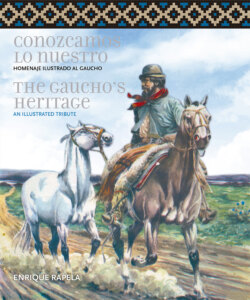Читать книгу Conozcamos lo nuestro - The Gauchos's Heritage - Enrique Rapela - Страница 26
e Calzoncillo,
cribo and spurs
ОглавлениеThe calzoncillo could have fringes that were made fraying the fabric; but the greatest luxury was the cribo, the openwork embroidery made with a needle (A). The more complicated, the more luxurious it was supposed to be. The countryman didn’t pronounce “cribado” but “cribao”.
A very important part of the gaucho concerning his customs and habits is something that was both a tool and a luxury: the spurs. They were secured to the heels to spur the horse, an essential element for his life as a man of the land.
The indigenous people also used the spurs, they took advantage of a hard wood, as shown in drawing (B). They also made spurs with sharpened deer horns. Usually, indigenous people took great care of their “montados” [horses], because their lives depended on them. The first spurs that were used in this part of the Globe were the ones called “prod spurs”, similar to the spurs the crusaders used during the Middle Ages (C).
Afterwards, the rowel spurs or “nazarenas” showed up. Some spurs are true jewels, made by well-known silversmiths, whose signature appears in pieces that today are in museums and famous collections.
The nazarenas were large: some of them weighted more than three kilos. There is not certain why there were called “nazarenas”, name with which the gaucho knew them. Some give as a cause the similarity between the shape of the nimbus and the crown of Jesus the Nazarene. Regarding the name “lloronas” [weeping women], there is a version that attributes the name to the rhythmic and monotonous sound they make when the gaucho walks with his slow pace, something characteristic of a horseman.
The different parts of the spur and the chains or ropes with which they adjust to the foot have their name; to describe them would be very difficult to understand; therefore, we show them graphically in (D). Spurs had infinity of shapes and sizes: made of silver, beautifully chiseled, with inlaid gold, but usually they were made of iron. As today, the variety depended on the purchasing power of each person.
